Menu
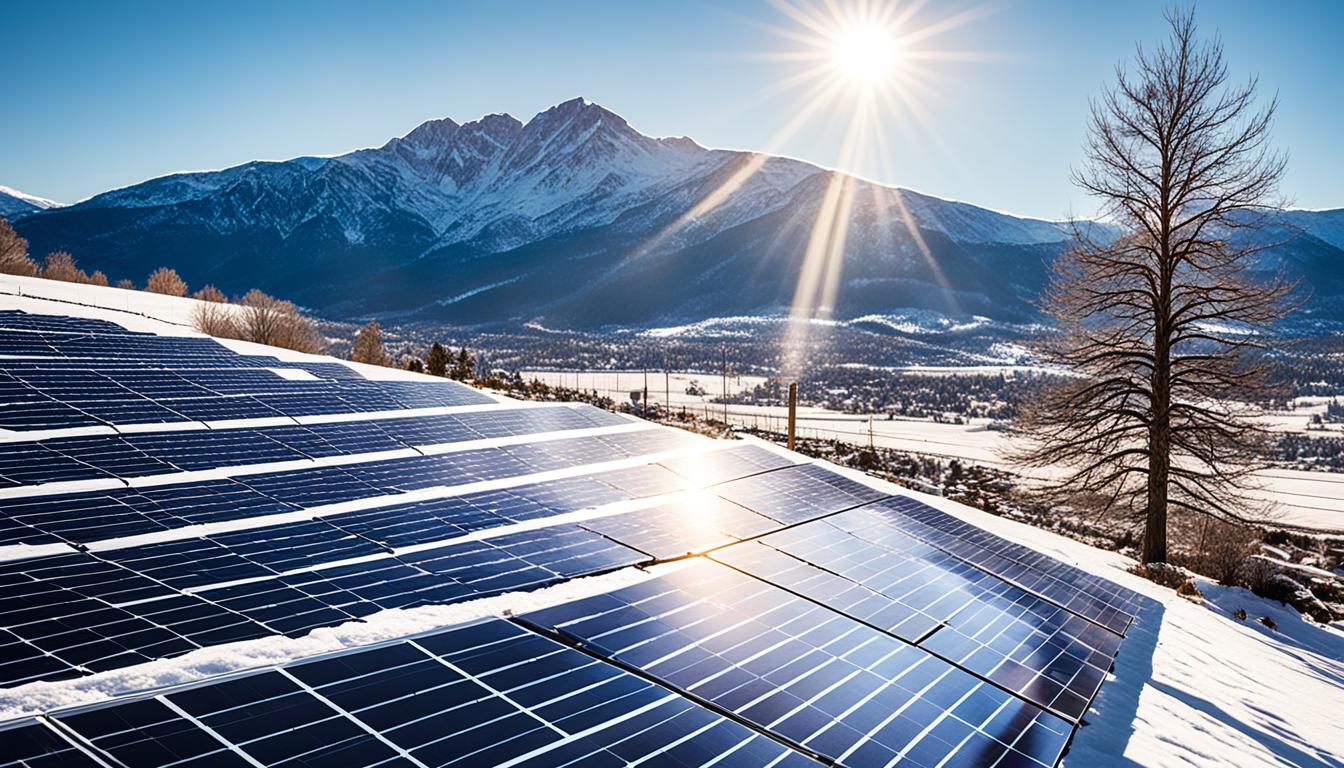
Did you know more than 1.3 million UK homeowners use solar panels? Also, around 150,000 homes in the UK are off-grid. This shows a big shift towards greener energy and off-grid living.
Living off-grid is a choice for many to be more eco-friendly. By using solar panels and other renewable energy, people take control of their energy. They cut down on their carbon footprint and help the planet.
At first, a 4kW solar system might seem expensive, around £9,500. However, with reduced energy bills, the costs even out. Off-grid living can save up to 70% on bills. This makes it a smart choice for many.
Living off the grid means aiming for self-sufficiency. You don’t rely on things like electricity from the grid. Instead, you use eco-friendly ways to get your power. Thanks to new technology, living like this is now easier and smarter.
Off-grid living is being completely independent in how you get your power. This can be through solar energy, wind power, or other natural means. By doing this, people can live in places that are far away or don’t have many services. It also helps the environment by reducing their impact on it.
Key components of off-grid systems work together to create a complete setup. This setup allows people to live without the need for outside power.
Each part of an off-grid system is important and fits together perfectly. Using different energy sources makes the whole setup stronger. This way of living is good for the Earth and offers reliable power options.
Living off-grid has many advantages. It can help the planet, save money, and give you independence. Those focused on sustainable off-grid energy solutions see these as key goals. These include living in a way that’s good for the Earth, financial security, and being free from public energy sources.
Going off-grid is great for the environment. By using eco-friendly energy options like solar and wind, you can cut down on fossil fuels. Solar panels make clean, emission-free energy. Wind turbines also turn the wind into power, making your carbon footprint smaller.
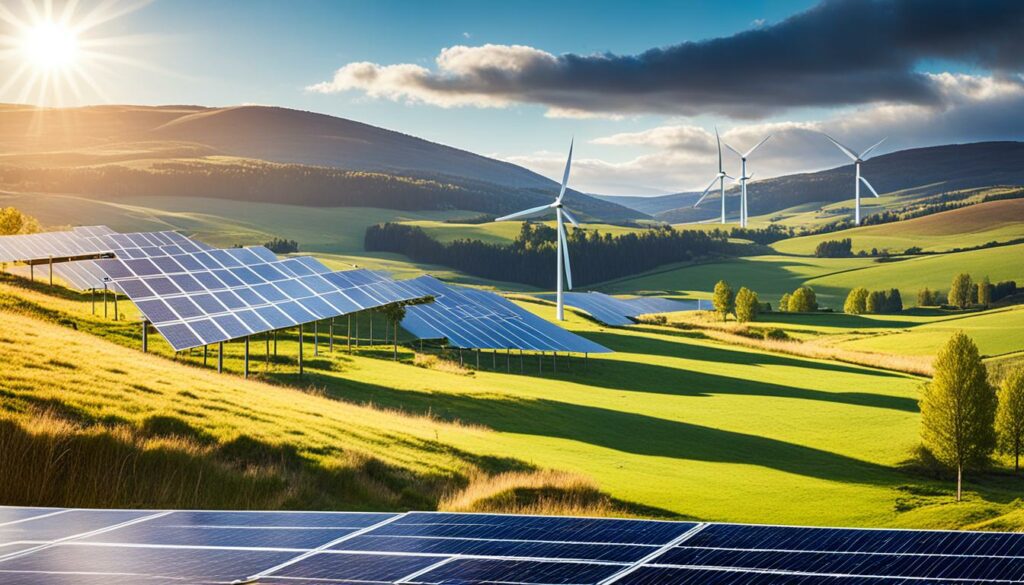
Living off-grid can mean big savings. Making your own energy cuts or removes your bills. For example, in northern New Mexico, an off-grid home saves money by using a rain catchment system for water and a wood pellet stove for heating. These choices save a lot of money and make the family less reliant on outside help.
Being off-grid means you control your energy. With sustainable off-grid energy solutions, you’re not at the mercy of power companies. So, if the grid goes down, your power doesn’t. You’ll have your own, steady source of energy. This freedom means you can plan your energy use and costs better, with more security.
Choosing the best renewable energy sources involves looking at their efficiency, cost, and how they help the environment. Solar and wind power are top options. They offer clean ways to generate energy.
In places where sunlight is abundant, solar power shines. Its technology has progressed, making solar panels more efficient and cheaper. This is especially handy in remote areas where connecting to the grid is hard or costly.
Wind power is great where there’s lots of wind. It’s a smart choice for homeowners in such areas. They can install small wind systems that work all the time, creating quite a bit of power.
| Renewable Energy Source | Pros | Cons |
|---|---|---|
| Solar Power | Abundant, low maintenance costs | Intermittent production, high installation costs |
| Wind Power | Generates electricity continuously, cost-effective in windy areas | High upfront costs, visual/noise impact |
Using solar and wind power together in a hybrid system can be the best approach. They cover each other’s downtime, ensuring a more reliable energy supply. This approach is key to maximising efficiency and meeting energy needs.
Thinking about solar panels for off-grid living can lead to a lot of choices. It’s important to know the types and how they work. By picking the right one, you can make your home more energy efficient and eco-friendly.
For off-grid living, you’ll see monocrystalline, polycrystalline, and thin-film panels. Monocrystalline is the top choice for efficiency and lifespan, but it costs more. Polycrystalline offers a good mix of performance and price. Thin-film, though less efficient, is flexible and simple to set up. The best one depends on your needs and budget, impacting how well your system runs.
Putting in off-grid solar panels is a detailed process. First, experts check the site to find the best spot for sunlight. Then, the panels are mounted correctly, focusing on the perfect angle and facing direction. The last step is connecting everything electrically, from inverters to batteries. This step makes sure the system works smoothly. The cost to install can vary, but a simple system might cost between $5,000 and $15,000.
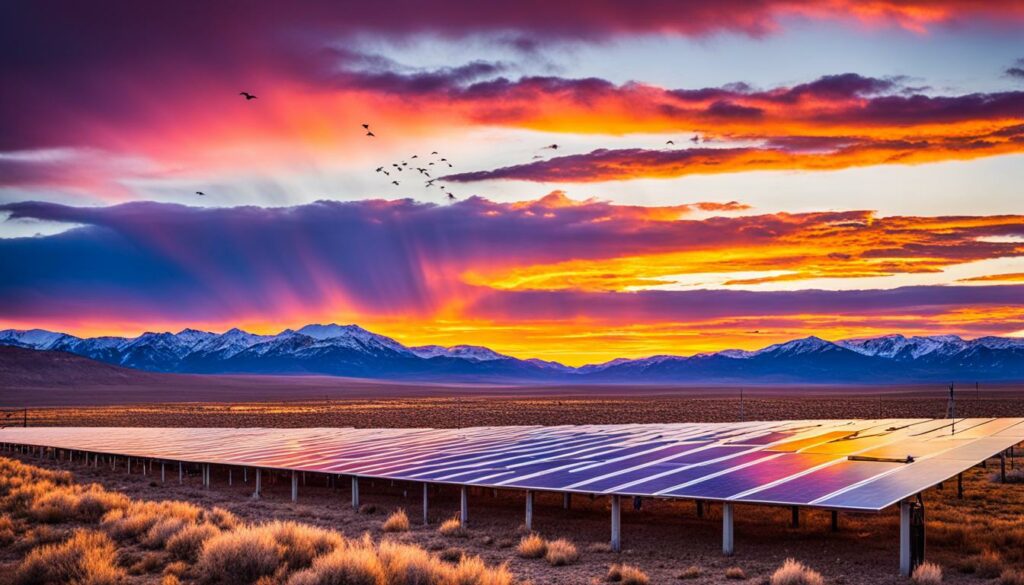
Keeping your off-grid solar system in shape is key for it to last and work well. Regular cleaning clears them from dirt, boosting their efficiency. It’s also smart to check that everything’s still sturdy. Using performance tracking tools helps spot problems early. This kind of care can extend the lifespan of solar panels beyond 25 years, offering a long-term energy solution.
Off-grid solar panels offer many benefits. Lowering your energy bills and disconnecting from the main grid are just some. A good system can include solar panels, batteries, and even windmills or gas. This mix ensures power in all situations, lowers your costs, and keeps maintenance troubles at bay.
In the world of off-grid energy, battery storage is key. It keeps things running when the sun isn’t shining. This keeps renewable energy reliable all the time.
Battery storage is crucial off the grid. It helps keep power running, even on dark or cloudy days when solar panels slow down. With more renewable energy coming, a flexible and strong energy system is needed. Big batteries, like those from EVESCO, come in various sizes, from just a few to hundreds of MWh, to meet different needs.
It’s important to know the different solar batteries available. They come in various sizes, last different lengths of time, and need different levels of care.
Battery systems make renewable energy systems stronger. They help deal with changes and can be put in different spots to make things more reliable and flexible. Smart software also helps manage and checks energy use, making systems more efficient and reliable.
With people wanting cleaner energy, batteries are a must. They help in small and big places, making true energy freedom possible.
Heating water off-grid is a bit tricky. Yet, there are many eco-friendly ways to do this. These use sustainable energy sources rather than needing electric hot water tanks. These can be costly and don’t work well off-grid.
Solar water heaters are a top pick for eco-conscious people. The evacuated tube solar system is great because it works well even on cloudy days. It captures the sun’s energy with black pipes under glass, heating the water without electricity.

The Sunbank solar heater is a great choice, despite being a bit more expensive at first. Many Sunbank users install it themselves because it’s easy to set up. It comes in sizes of 40 and 80 gallons, fitting many needs for off-grid heating. It doesn’t use electricity or propane, making it very green.
| Solar Water Heating Solutions | Key Features |
|---|---|
| Evacuated Tube Solar | Efficient in cloudy conditions |
| Sunbank Solar Heaters | No electricity/propane needed, 40 and 80-gallon systems, 30% Federal Tax Credit |
Wood and pellet stoves are also good for heating water off the grid, especially in winter. They burn sustainable materials like wood or pellets to heat water. Stoves with wetbacks warm water as it’s circulated around the fire, offering a green way to live off-grid. For an easier start to hot water, a simple off-grid bucket shower is a good choice.
By using these methods for off-grid water heating, you stay comfortable and use less non-renewable energy. This helps our planet in the long run. Choosing these advanced and old-fashioned ways mixes modern convenience with care for the environment.
Adding wind turbines to an off-grid setup is a smart move for energy independence. It lets us use other power sources. For off-grid systems to work well, picking and setting up these turbines must be done with care.
Picking a wind turbine depends on your energy needs and where you are. By 2050, we expect a huge increase in onshore wind power, reaching 5044 GW. This growth shows why picking the right turbine size is crucial.
Today’s wind turbines have smart tech like the doubly fed induction generator. This tech can slash wind power changes, making turbines more stable and efficient. Understanding if traditional generators can track loads without extra backup at low wind power levels also helps choose well.
Getting the installation right is key for safety and performance. The site for a wind turbine in an off-grid area should be perfect. We need to look at things like wind patterns, the land, and how close it is to buildings. Bad installation can lower performance and safety.
Using strong energy storage is vital for steady, cost-effective, and safe power. For example, hybrid systems store power better and add energy faster than older methods. Adding efficient storage, like battery systems, to wind power can even out the energy flow. This keeps the power steady when the wind is weak.
| Statistic | Figure |
|---|---|
| Total global wind capacity by 2018 | 597 GW |
| Projected onshore wind capacity by 2030 | 1787 GW |
| Projected onshore wind capacity by 2050 | 5044 GW |
| Fluctuation reduction by doubly fed induction generator | 90% |
| Power fluctuation reduction by SPSA-based power management | 81% in 90% of operation time |
Bringing wind turbines into off-grid systems boosts self-reliance and trust in renewable energy. Choosing wisely and installing carefully means wind turbines can help build a cleaner, more self-reliant energy world.
Hybrid solar systems cut down electricity bills and help manage energy better. They work by joining solar panels with things like wind turbines. This mix grabs more energy, making it a strong tool for energy self-sufficiency.
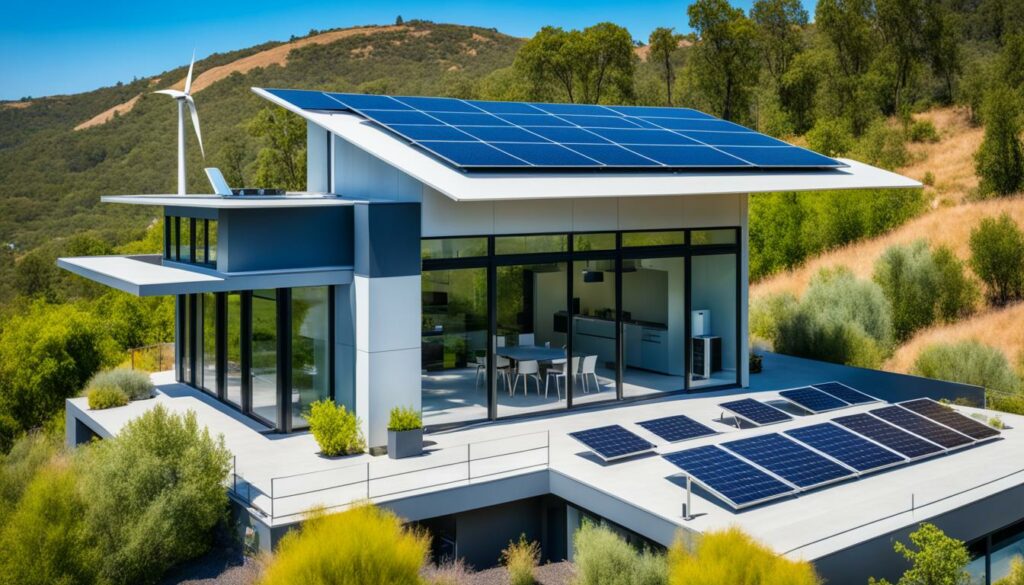
One key benefit is they use stored solar energy when it is most needed, like during peak hours. This is helpful because you can sometimes sell extra energy back. Plus, it helps you use power more wisely based on your needs.
They can reduce your energy costs by making the most of what is available, especially in areas where power rates can get high. They keep your home running even when there’s no power from the grid. This makes your home more self-reliant and earth-friendly since solar power uses no greenhouse gases.
Where you live and the climate greatly affect how well hybrid systems do. Sunny places get the best from solar panels and other solar tech, making the setup efficient and reliable.
The initial costs of setting up a hybrid solar system can be high. But, this is getting better as the tech improves and more people want them. You also need to think about the cost of keeping them up, including battery changes and keeping solar panels clean.
But, these systems do guarantee more independence from the usual power grids. They can make sure you always have power by using batteries when needed. This makes your house less reliant on outside energy, cutting down on both bills and harmful emissions.
| Hybrid System Benefits | Challenges |
|---|---|
| Reduction in Electricity Bills | Higher Upfront Costs |
| Energy Independence | Battery Replacement Costs |
| Sustainability | Maintenance Requirements |
| Control Over Energy Usage | Climate Dependency |
In the end, hybrid solar systems are heading towards becoming vital for our eco-friendly future. They support both energy freedom and green living.
Looking at real-life examples of off-grid living gives us great insights. It also encourages people to use sustainable off-grid energy solutions. Here, I will talk about two case studies. They show how eco-friendly energy options work well in different places.
The Mathers’ home in Ontario is a top model for off-grid living. They use both wind and solar power for a steady energy source. They also keep food cool in a root cellar and get food from a local agriculture program. This shows smart ways to live without needing others’ help.
Mixing wind and solar power meets a big worldwide goal. This goal is to have much more renewable energy in use by 2030. It points out the value of having many kinds of clean energy. It also shows how using eco-friendly energy options can make our lives better.
Certain projects have also shown us how well eco-friendly energy options work. For example, homes in Australia use solar, wind, and geothermal energy. This shows that sustainable off-grid energy solutions can be changed for different places. It depends on what kind of energy sources the area has and its weather.
Here are some key facts to think about these projects:
The new tech and creative energy use in these case studies show us we can thrive off-grid.
| Project | Location | Energy Sources | Special Features |
|---|---|---|---|
| The Mathers’ Homestead | Ontario, Canada | Solar, Wind | Root Cellar, CSA Program |
| Hybrid Systems | Australia | Solar, Wind, Geothermal | Highly Customisable |
The government is essential in boosting solar and other clean energies. They provide incentives and grants. These help households make the switch to sustainable power like off-grid solar panels easier and more affordable.
The Solar ITC gives a big tax break. It’s at 26% until the end of 2022, drops to 22% in 2023, and down to 10% for businesses in 2024. Residential projects will no longer get this credit after that. This makes installing off-grid solar panels cheaper.
The MACRS is another helpful tool. It lets solar equipment get tax breaks faster over five years. This means the total cost goes down earlier, making off-grid solar even more attractive.
State net metering policies are also crucial. They are found in 44 states and DC. Net metering credits homeowners for extra electricity sent to the grid. This cuts energy costs and supports green power.
Grants for renewable energy are important too. The Solar Energy Technologies Office is working to make solar cheaper. Their work includes helping local governments, which cuts solar costs.
The DOE aims to bring down large solar system costs significantly. They want to drop utility-scale solar costs from 4.6 cents per kWh to 2 cents by 2030. This shows a strong drive to make renewable energy systems more budget-friendly.
| Programme | Description | Benefit |
|---|---|---|
| Solar Investment Tax Credit (ITC) | 26% tax credit for solar projects through 2022, reducing over time | Financial Incentive |
| Modified Accelerated Cost Recovery System (MACRS) | 5-year accelerated depreciation for solar equipment | Cost Reduction |
| Net Metering Policies | Credits for excess electricity sent back to the grid | Cost Savings |
| State-Level Grants | Various programmes to support solar adoption | Financial Support |
These grants and incentives show strong government support. They aim to make renewable energy more widespread. By making off-grid solar more attractive, they encourage a greener tomorrow.
Living off-grid has many good sides. But, it also brings some challenges. To be off-grid, you need to plan and invest in solar panels or wind turbines. This is key to succeed in living off-grid.
The first big challenge in going off-grid is the cost. Setting up solar panels, wind turbines, and hydroelectric systems needs a lot of money. A 2020 study showed that careful planning and spending your resources right can help cut these costs. Remember, setting up isn’t just about energy. Things like water systems and eco-friendly homes also add to the big start-up bill.
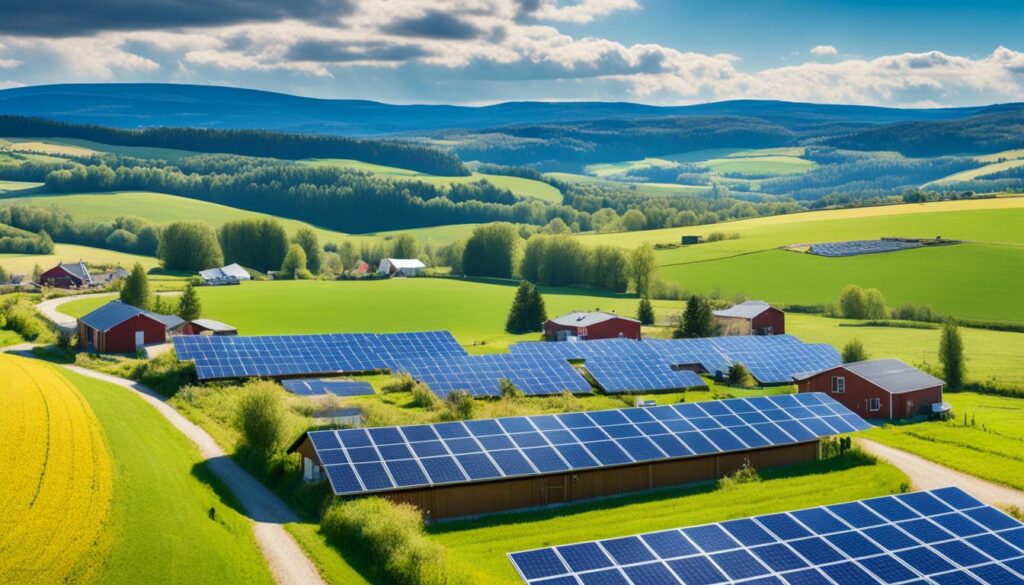
Keeping energy systems working well is important. Solar panels need regular cleaning. Wind turbines and hydroelectric systems also need to be checked and fixed often. Avoiding too much power use is a must to stop the system from breaking down. You also need various skills, like building and farming, to live off-grid. This way, your energy setups will last longer.
This table shows how different off-grid systems work:
| Power Generation | Components | Benefits | Challenges |
|---|---|---|---|
| Solar Panels | Photovoltaic Cells, Inverters | Low Emissions, Renewable | High Initial Cost, Maintenance |
| Wind Turbines | Turbine Blades, Generator | Efficient in Windy Areas | Space Requirements, Noise |
| Hydroelectric | Turbines, Dams | Consistent Power Source | Environmental Impact, Initial Cost |
| Gas Generators | Internal Combustion Engine | Reliable Backup | Fossil Fuel Dependence, Emissions |
Off-grid life also involves managing waste. Practices like using composting toilets and recycling help the planet. Though, it might be tough at first. Another hurdle can be feeling quite isolated in some remote places. Despite these challenges, living off-grid can lead to personal growth. Planning for the challenges can make the move to off-grid living easier, using alternative energy sources effectively.
Reaching full energy independence technology with off-grid solutions is a unique journey. It involves finding the right mix of renewable energy sources that fit the needs of each person. This approach uses resources like solar, wind, and geothermal energy to become truly self-sufficient.
Off-grid solar systems really change things for the better. They cut energy costs, need little upkeep, and reduce our carbon footprint. Living off-grid means we don’t have to rely on central power grids, which makes us less vulnerable.
Adding wind energy to the mix brings in more clean power. Combining wind turbines with solar panels boosts efficiency and reliability. Together, they create a strong system for sustainable power.
It’s also important to use the best in storage technology, like CAES and electrochemical systems. They ensure power is available even when the sun isn’t shining or the wind isn’t blowing. This makes energy supply smooth, no matter the weather.
In February 2024, the UK set new Hydrogen Car range records, showing the power of new technology in energy independence. Nuclear SMRs also help, offering clean energy and supporting renewable sources. These advances strengthen the move to sustainable power solutions.
| Technology | Application | Benefits |
|---|---|---|
| Off-Grid Solar Systems | Residential Power | Reduced Energy Costs, Low Maintenance |
| Wind Energy Solutions | Renewable Electricity Supply | Reliability, Clean Energy |
| Compressed Air Energy Storage | Energy Storage | High Capacity, Long Duration |
| Electrochemical Storage | Off-Grid Systems | Efficiency, Stability |
Using these technologies helps achieve energy independence. It supports a sustainable life and lets us break free from traditional energy limits. By 2034, the Solar EV Charging market could be worth US$2.5 billion, showing a big move towards off-grid solutions.
The world of off-grid energy is changing fast. This change is powered by new tech and how the market is shifting. Looking ahead, new trends in renewable energy stand out as great ways to improve living off-grid.
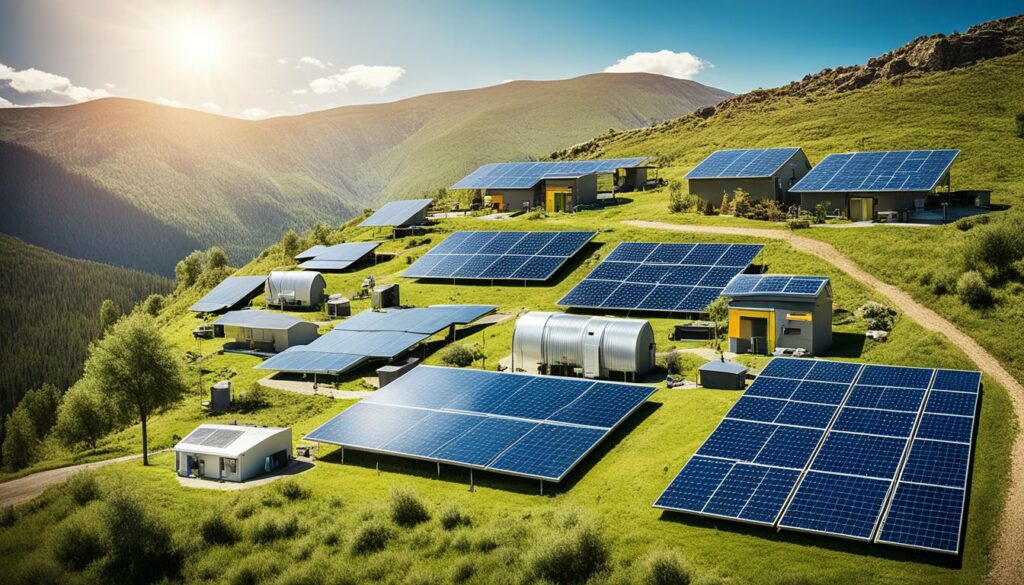
Solar technology keeps getting better. Now, we have solar panels that work more efficiently. They can turn more sunlight into power, even in places that aren’t very sunny. There are also solar roof tiles. These can fit into buildings well, making them look good while gathering lots of energy. This means renewable energy is getting easier and better for people living off-grid.
Battery storage is also seeing big improvements. This is key for having power when you need it, without being connected to the grid. The market for off-grid batteries is growing fast. People really want power solutions that are both reliable and good for the planet.
Lithium-ion batteries are popular because they last a long time and are powerful. But Redox Flow Batteries are also getting attention. They last even longer and can be made bigger or smaller to suit different needs. And now, using old electric vehicle batteries for energy storage is becoming a smart choice.
Big names like Samsung SDI and Sumitomo Electric are leading the way. They’re trying to outdo each other with new ideas all the time. Better battery storage helps deal with the ups and downs of renewable power. It keeps things running smoothly off-grid. Plus, more often than not, these systems are controlled and tweaked from afar thanks to cloud tools.
Choosing sustainable off-grid energy isn’t just about being independent and resilient. It fits our wider green goals too. To start your energy-autonomous journey, you need to know about solar systems for off-grid living. This includes systems like grid-tied with battery backup, off-grid solar, and hybrid solar. Solar generators give you continuous power backup.
To keep off-grid renewable energy systems working well, monitoring and maintenance are key. Figure out how much energy you use each day in watt-hours. This helps you pick the right renewable energy system. Remember, there’s more than solar power. Check out hydro energy systems too. They include impoundment, diversion, and pumped storage.
For storing energy off-grid, different kinds of batteries are essential. You’ll find lead-acid, lithium-ion, and flow batteries. Biomass systems, like wood-burning stoves and biodiesel generators, offer green alternatives. Don’t forget about wind turbines. They come in different types and can really help in designing your off-grid energy system.
By using many renewable energy sources, you get a more dependable and strong energy supply. Combining this with good insulation and efficient appliances boosts your system even more. The number of people using off-grid renewable energy rose a lot from 2011 to 2016. With the costs of solar PV going down, going off-grid sustainably is easier now. By 2030, over 60% of new electricity is expected to come from renewable sources. This marks an important move towards a greener, more independent future.
Off-grid living means not depending on public utilities like the national electricity grid. People who choose this life use eco-friendly energy options. Solar panels and wind turbines are common for making electricity.
These systems need solar panels to gather energy from the sun. They use inverters to change this energy and battery banks to save it. Sometimes there are generators for back-up power.
Living off-grid lowers your carbon footprint because you don’t produce harmful emissions. Solar panels and other eco-systems help make our planet greener and healthier.
Going off-grid can save you money on energy bills. Plus, through net metering, you might even make some money. These savings can cover the cost of your energy system over time.
To be energy independent, use a mixture of renewable sources that suit your home and where you live. This way, you’re not affected by the ups and downs of public grids.
There are three main types of solar panels: monocrystalline, polycrystalline, and thin-film. The first is top for efficiency. The second is less expensive but still good. Thin-film panels are useful because of their flexibility and light weight.
Setting up solar panels starts with finding the best place for them. Then comes securing and connecting them. A good installation helps your panels work better and last longer.
Battery storage is key for keeping power flowing when the sun or wind isn’t available. It offers independence and reliability in your power system.
Options include solar water heaters and biomass stoves like those for wood or pellets. These choices are kind to the planet and work well for off-grid homes.
Think about your power needs and the place where you live. Wind speed, turbine size, and local rules matter. Choosing the right turbine helps your energy system work effectively.
Hybrid systems use different renewable sources together. They boost power production and reliability, offering a stronger energy supply for off-grid life.
The Mathers’ homestead in Ontario is a great off-grid example. They use wind and solar power, plus smart storage and agriculture. Such homes show off-grid living can work well in various places.
Yes, the government offers incentives for using renewable energy. This includes benefits for sharing energy back with the network. It makes off-grid options more affordable.
The start-up costs can be high because you need things like solar panels. But, planning well shows that these costs are worth it for future savings and benefits.
Regular check-ups like cleaning panels and looking for damage are vital. Choosing high-quality parts and knowing how to care for them lessens the maintenance work.
New solar tech and better batteries are going to change off-grid living. This means more efficient and eco-friendly ways to keep your home powered.